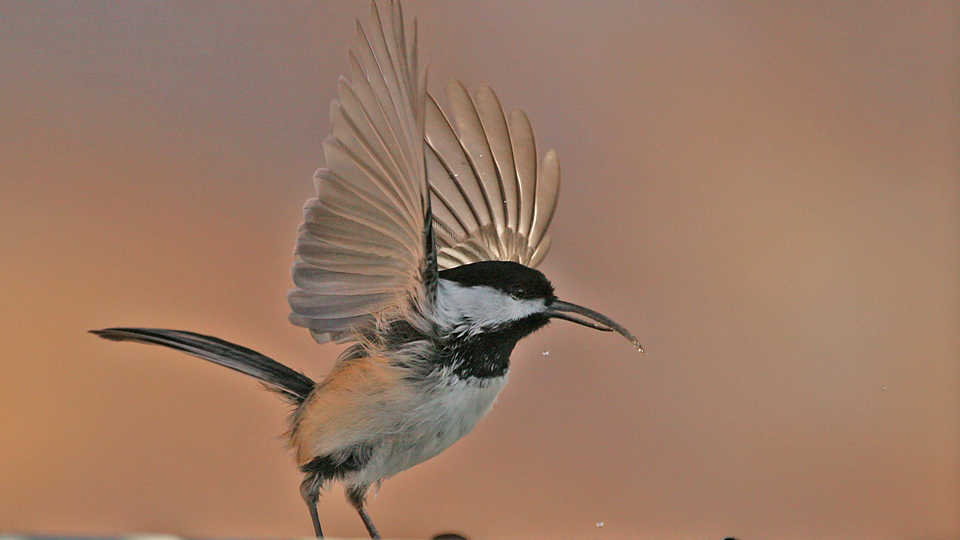Science News
Solving Beak Deformities

In the 1990s, scientists began to observe beak deformities in a population of black-capped chickadees (Poecile atricapillus) in south-central Alaska. By the early 2000s, these abnormal elongations, crossings, and curvatures were noticed in other birds—including nuthatches, woodpeckers, crows, jays, and other corvids—throughout Canada, the Pacific Northwest and other parts of the U.S, and even Europe and Asia. But the disease behind the deformities, which researchers labeled Avian Keratin Disorder (AKD), remained a mystery.
AKD isn’t simply cosmetic—the deformities impair basic behaviors for the birds. “These beak deformities can severely handicap the affected birds, which suffer higher rates of mortality and raise fewer young than unaffected individuals,” says Colleen Handel, a scientist with the U.S. Geological Survey who first discovered AKD in Alaska and began to document its distribution.
“Take one look at a bird suffering from Avian Keratin Disorder, and you’ll understand the importance of stopping its spread,” says the Academy’s bird expert Jack Dumbacher. “Birds must be able to feed themselves and preen their plumage by carefully spreading waterproofing oils on their feathers. When deformed beaks restrict them from these life-giving activities, birds become cold, hungry, and often die. We’re trying to understand the causes, origins, and distribution of this disorder.”
And they may be a step closer to that understanding. Last week, Handel, Dumbacher and colleagues published a study in the journal mBio revealing a new virus that might be the cause of AKD.
Cutting-edge genetic testing allowed the interdisciplinary team of researchers to track down a cryptic virus hiding in extracts of bird DNA. In the past, collaborations between the Academy and UC San Francisco used identical techniques to identify an important new virus that causes Inclusion Body Disease in boas and pythons—a discovery that has since led to insights in the evolution of serious human diseases such as Ebola. In the AKD-focused study, the team took tissue samples from both sick and healthy birds and applied advanced sequencing technology to pull out genetic information from microbes living in these birds.
The sequencing process involved sifting through hundreds of thousands of DNA fragments, comparing them to known virus groups (including those commonplace among birds), and then isolating those that appeared to be a match or near-miss. From the pile of fragments of potential viruses sprang a new suspect belonging to the picornavirus family—a large and diverse group that includes well-known human offenders such as polio, hepatitis A, and the common cold. The team named their discovery “poecivirus” after the genus of black-capped chickadee, Poecile, from which the sequences originated.
Though more research is necessary to establish poecivirus definitively as the main cause of AKD, it remains the strongest lead yet. As part of the new virus description, the team generated a detailed map of poecivirus’ genetic material—a tool that will enable scientists all over the world to aid in its identification among birds exhibiting clinical signs of AKD.
“We don’t know if poecivirus is causing this pathology, but we do know that this virus is not limited to chickadees,” says Maxine Zylberberg, UC San Francisco researcher and lead author of the study. “We detected poecivirus in red-breasted nuthatches and northwestern crows with beak deformities, as well as in every chickadee with AKD that we have tested. More work is needed to determine if poecivirus is causing AKD, but the evidence suggests that it is a strong candidate.”
Beyond a definitive link, the scientists are also examining how AKD is transmitted and how the disease stimulates abnormal beak growth. And everyone can help! If you encounter a bird in the wild with a particularly curved, crossed, or elongated beak, you can help by submitting an observation report with the species type, behavior, the time and location of your sighting, and any accompanying photographs. “The power of citizen science can help us identify other clusters of AKD around the world,” says Handel.
“Identifying and sequencing this new virus has really added to our scientific tool belt,” says Dumbacher. “Now it’s time to look to nature, and start searching broadly for other instances of poecivirus around the globe.”
Image: Black-capped chickadee, John Hohl


